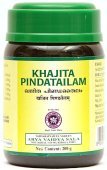Shariba, Sāribā, Sariba, Śāribā: 6 definitions
Introduction:
Shariba means something in Hinduism, Sanskrit, Buddhism, Pali, biology. If you want to know the exact meaning, history, etymology or English translation of this term then check out the descriptions on this page. Add your comment or reference to a book if you want to contribute to this summary article.
The Sanskrit term Śāribā can be transliterated into English as Sariba or Shariba, using the IAST transliteration scheme (?).
In Hinduism
Ayurveda (science of life)
Kalpa (Formulas, Drug prescriptions and other Medicinal preparations)
Source: Shodhganga: Edition translation and critical study of yogasarasamgrahaŚāribā (शारिबा) refers to the medicinal plant known as “Hemidesmus indicus R. Br.” and is dealt with in the 15th-century Yogasārasaṅgraha (Yogasara-saṅgraha) by Vāsudeva: an unpublished Keralite work representing an Ayurvedic compendium of medicinal recipes. The Yogasārasaṃgraha [mentioning śāribā] deals with entire recipes in the route of administration, and thus deals with the knowledge of pharmacy (bhaiṣajya-kalpanā) which is a branch of pharmacology (dravyaguṇa).
Toxicology (Study and Treatment of poison)
Source: Shodhganga: Kasyapa Samhita—Text on Visha ChikitsaŚāribā (शारिबा) [Cf. Śārivā] is the name of a herbal ingredient which is included in a (snake) poison antidote recipe, according to the Kāśyapa Saṃhitā: an ancient Sanskrit text from the Pāñcarātra tradition dealing with both Tantra and Viṣacikitsā—an important topic from Āyurveda which deals with the study of Toxicology (Viṣavidyā or Sarpavidyā).—In the Añjana or Collyrium segment of the eighth Adhyāya, Kāśyapa prescribes eight types of permutation and combination of herbs that effectively arrest poison. According to Kāśyapasaṃhitā (verse VIII.39b-40), “Arjuna, Kuṣṭha, Nata, Vyoma, Tulasī, Śāribā, Dhana, Helā, Hiṅgu,Vacā,Yaṣṭhi,Vilaṅga, Sindhu, honey boiled in the latex of Palāśa and salt water and stored in the horn of a cow, applied as collyrium treats poison effectively”.
Source: Shodhganga: Kasyapa Samhita—Text on Visha ChikitsaŚāribā (शारिबा) [Cf. Śārivā] is the name of an ingredient used in the treatment (cikitsā) of immobile or plant poison (sthāvaraviṣa), according to the Kāśyapa Saṃhitā: an ancient Sanskrit text from the Pāñcarātra tradition dealing with both Tantra and Viṣacikitsā—an important topic from Āyurveda which deals with the study of Toxicology (Viṣavidyā or Sarpavidyā).—The 12h adhyāya of the Kāśyapasaṃhita also deals with the mantras for curing immobile or plant poison (sthāvara-viṣa) as well as antidotes made of medicines that quell the same.—Accordingly, “A decoction of Kośātakī, Agni, cinnamon, Sūryavallī, Amṛta, Abhayā, Śleṣmātaka, Śirīṣa, Karṇikā, Kāśmarī, two kinds of Niṣā, Punarnāvā Bṛhatī and Kaṇṭhakārī, two varieties of Sārivā (śāribā) and Trikaṭu cooled and mixed with ghee and honey is useful in totally decimating plant-poison”.

Āyurveda (आयुर्वेद, ayurveda) is a branch of Indian science dealing with medicine, herbalism, taxology, anatomy, surgery, alchemy and related topics. Traditional practice of Āyurveda in ancient India dates back to at least the first millenium BC. Literature is commonly written in Sanskrit using various poetic metres.
Biology (plants and animals)
Source: Wisdom Library: Local Names of Plants and DrugsSariba in the Sanskrit language is the name of a plant identified with Decalepis hamiltonii Wight & Arn. from the Apocynaceae (Oleander) family. For the possible medicinal usage of sariba, you can check this page for potential sources and references, although be aware that any some or none of the side-effects may not be mentioned here, wether they be harmful or beneficial to health.
Source: Google Books: CRC World Dictionary (Regional names)1) Sariba in India is the name of a plant defined with Decalepis hamiltonii in various botanical sources. This page contains potential references in Ayurveda, modern medicine, and other folk traditions or local practices.
2) Sariba is also identified with Ichnocarpus frutescens It has the synonym Quirivelia zeylanica Poir. (etc.).
Example references for further research on medicinal uses or toxicity (see latin names for full list):
· Hortus Kewensis (1811)
· Philippine Journal of Science (1922)
· The Flora of Tripura State. (1981)
· Journal of Botany (1923)
· Flora of the British India (1883)
· Species Plantarum (1753)
If you are looking for specific details regarding Sariba, for example chemical composition, side effects, pregnancy safety, diet and recipes, extract dosage, health benefits, have a look at these references.

This sections includes definitions from the five kingdoms of living things: Animals, Plants, Fungi, Protists and Monera. It will include both the official binomial nomenclature (scientific names usually in Latin) as well as regional spellings and variants.
Languages of India and abroad
Pali-English dictionary
Source: BuddhaSasana: Concise Pali-English Dictionarysāribā : (f.) the Sarsaparilla plant.

Pali is the language of the Tipiṭaka, which is the sacred canon of Theravāda Buddhism and contains much of the Buddha’s speech. Closeley related to Sanskrit, both languages are used interchangeably between religions.
See also (Relevant definitions)
Starts with: Sharibadi.
Full-text (+1): Cariyam, Sariva, Nariuninti, Parivalli, Nannari, Griharajila, Kalodaravisha, Tuhina, Masha, Kalodara, Shelu, Padmaka, Nadambu, Visahara, Sindhu, Nata, Vilanga, Makshika, Hela, Dhana.
Relevant text
Search found 4 books and stories containing Shariba, Sāribā, Sariba, Śāribā; (plurals include: Sharibas, Sāribās, Saribas, Śāribās). You can also click to the full overview containing English textual excerpts. Below are direct links for the most relevant articles:
Cosmetics, Costumes and Ornaments in Ancient India (by Remadevi. O.)
2.7. Pharmaceutical use of Keśarāga (Hair dye) < [Chapter 1 - Cosmetics]
Rasa Jala Nidhi, vol 5: Treatment of various afflictions (by Bhudeb Mookerjee)
Chapter 16 - Symptoms and treatment of Trishna (thirst)
Chapter 1 - Symptoms and treatment of Raktapitta (Hemoptysis)
Chapter 2 - Symptoms and treatment of Rajayakshma (Phthisis or consumption)
Matangalila and Hastyayurveda (study) (by Chandrima Das)
Vaśālobha: The second technique < [Chapter 3]
Rasa Jala Nidhi, vol 3: Metals, Gems and other substances (by Bhudeb Mookerjee)
Part 7 - Incineration of iron (26) < [Chapter IV - Metals (4): Lauha (iron)]
Related products
(+23 more products available)





